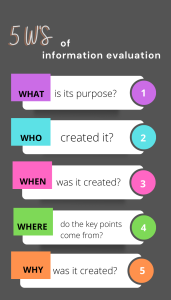5.7 The Journalistic Approach
The approach outlined here is based on the one outlined in an article written by Elmwood (2020) who adapted it from other scholars in various disciplines. As an information professional, Elmwood (2020) examined how to best teach post-secondary students web evaluation in the current, complicated online environment. The Journalistic or Investigative Approach offers students a somewhat structured framework (like RADAR) to follow but goes beyond the ‘yes/no’ oriented approach. The method suggests that seekers of information should use a series of questions utilized by professional journalists – what, who, where, when, why, and how.

Each of these questions can be explored in detail. To find the answers, one may need to use techniques from both the RADAR and SIFT framework. They may also need to find and read multiple sources to get adequate answers. They should be ready for unclear answers and be prepared to exercise judgment and make decisions about resources.
Journalistic Approach Example
Jean wants to apply the Journalistic Approach to a website called “Own it Voice It” (n.d.). The site was created to provide a voice for the tobacco consuming population. It aims to fight against a bill that will ban the sale of menthol cigarettes.

Below is the description of Jean’s process using the journalistic method and some of their thoughts while searching. Jean continued searching until they felt like they had enough information on the website and the issues presented within it. This will vary every time the journalistic method is used.
|
Journalistic Approach |
|
|
What
|
It’s a website. The purpose is to stop the ban of menthol cigarettes. It’s US based and highlights states where the ban may happen. There is mention of personal rights. There is a claim that tax revenue will be lost. |
|
Who
|
The copyright of the website is held by RAI Services Company, a subsidiary of Reynolds American Inc The About page doesn’t give more information. A search for RAI company doesn’t give much information. There is a page on Bloomberg.com that says it is part of the tobacco industry. A search for Reynolds American produces many results that identify it as a tobacco company. |
|
When
*Tip: if there is no date consider the following steps:
|
The copyright date is 2021. The contact form has a copyright date of 2022. The associated Facebook page was created in 2017, active until 2019. No recent posts. Associated YouTube page has one video from 2017 |
|
Where
|
It appears to be created in the US. On the Terms of Use page it states that it is operated in the US. It looks like there might be legal reasons for this. |
|
Why
|
It is meant for US adult citizens. This is mentioned on every page. It looks like it might be a petition and so, it would be important to only have those the law affects, sign it. |
|
How
|
There doesn’t seem to be any evidence used. There are many claims about personal rights. There are no references. Links are only to social media accounts held by Reynolds American The FDA is mentioned as the organization banning menthol cigarettes. Information on the FDA website does explain the ban on menthol as a method to prevent young adults from starting to smoke. The CDC is mentioned to support the claim that tax revenue will be lost. Information on the CDC website does mention that Reynolds American is 1 of 4 top tobacco producers in the US. The claim on the website is taken out of context and doesn’t tell the whole story. Here is the quote from the CDC: “However, in fiscal year 2021, states will receive $26.9 billion from tobacco taxes and cigarette company payments from the lawsuits they settled in 1998, but will only spend $656 million—less than 3% for tobacco control programs” (CDC, 2022). |
|
Notes about the source. Final thoughts. Lessons learned. |
“Own It Voice It” is a website owned by a tobacco company that is trying to increase support opposing the ban on menthol cigarettes. As a company that makes money on tobacco sales, it can be viewed as biased. It could link out to the sources it quotes, but it does not. |
As seen in the example above, the journalistic method asks questions that need a deeper analysis of a source. It may not provide a definitive answer regarding if a source can be trusted, but rather requires that the searcher come to a conclusion on their own. Using this approach provides more context to make informed decisions.

